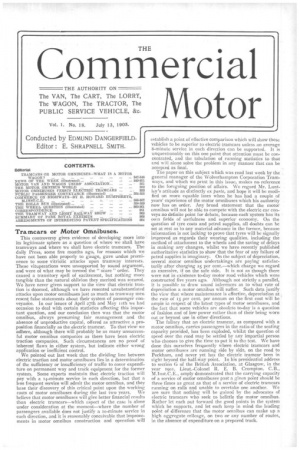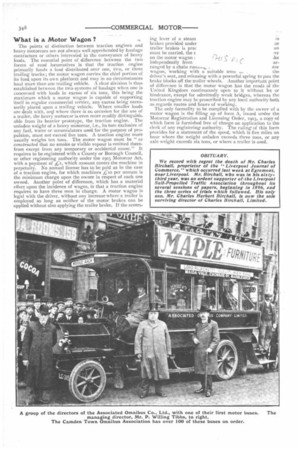Tra mcars or Motor Omnibuses.
Page 1

Page 2

If you've noticed an error in this article please click here to report it so we can fix it.
This controversy gives evidence of developing more into its legitimate sphere as a question of where we shall have tramways and where we shall have electric tramcars. The daily Press, some five months ago, for reasons which we have not been able properly to gauge, gave undue prominence to some vitriolic attacks upon tramway interests. These vituperations were unsupported by sound argument, and were of what may be termed the " scare" order. They caused a transitory spell of excitement, but nothing more tangible than the natural oblivion they merited was secured. We have never given support to the view that electric traction is doomed, although we have resented unsubstantiated attacks upon motor omnibuses just as much as tramway men resent false statements about their system of passenger conveyance. In our issues of April 27th and May i ith we had occasion to deal with certain statistics affecting this important question, and our conclusion then was that the motor omnibus, always presuming fair management and the absence of unproductive capital, offered as attractive a proposition financially as the electric tramcar. To that view we adhere, although there will probably be as many unsuccessful motor omnibus companies as there have been electric traction companies. Such circumstances are no proof of inherent flaws in either system, but indicate either wrong application or inefficient control.
We pointed out last week that the dividing line between electric traction and motor omnibuses lies in a determination of the sufficiency or insufficiency of traffic to cover expenditure on permanent way and track equipment for the former system. Some experts maintain that electric traction will pay with a 14-minute service in each direction, but that a less frequent service will admit the motor omnibus, and they base their discovery of this critical point upon the working costs of motor omnibuses during the last two years. We believe that motor omnibuses will give better financial results than electric tramcars—which aspect of the case is alone under consideration at the moment—where the number of passengers available does not justify a ro-minute service in each direction, and it is reasonably conceivable that improvements in motor omnibus construction and operation will establish a point of effective comparison which will show these vehicles to be superior to electric tramcars unless an average 8-minute service in each direction can be supported. It is unquestionably on this one point that attention must be concentrated, and the tabulation of running statistics to that end will alone solve the problem in any manner that can be accepteci as final.
The paper on this subject which was read last week by the general manager of the Wolverhampton Corporation Tramways, and which we print in this issue, makes no reference to the foregoing position of affairs. We regard Mr. Luntley's attitude as distinctly ex arte, and hope it will be modified on more equable lines when he has had a couple of years' experience of the motor omnibuses which his authority now has on order. Any broad statement that the motor omnibus will not be able to compete with the electric car conveys no definite point for debate, because each system has its own fields of usefulness and superior economy_ On the question of tyre costs and petrol supplies, all doubts can he set at rest as to any material advance in the former, because information is not lacking to prove that tyres will be signally improved as regards their wearing qualities, including the method of attachment to the wheels and the saving of delays in making any changes, whilst we have recently published authoritative statistics to show that the fear of any failure of petrol supplies is imaginary. On the subject of depreciation, several motor omnibus undertakings are paying satisfactorily after charging 25 per cent —which charge we regard as excessive, if on the safe side. It is not as though there were not in existence to-day motor road vehicles which were constructed five years ago. Although not strictly a parallel, it is possible to draw sound inferences as to what rate of depreciation a motor omnibus will suffer. Such data justify the view that where maintenance is effective, depreciation at , the rate of is per cent, per annum on the first cost will be ample in respect of the latest types of motor omnibuses, and the fact that some vehicles are obsolete to-day is a question of fashion and of low power rather than of their being worn Out or beyond use in other directions.
The fallacy that an electric tramcar, as compared with a motor omnibus, carries passengers in the ratio of the seating capacity provided, has been exploded, whilst the question of speed over the road may be settled by any impartial person who chooses to give the time to put it to the test. We have done this ourselves frequently where electric tramcars and motor omnibuses are running side by side, on the road to Peckham, and never yet has the electric tramcar been in sight beyond the half-way point. In his presidential address to section G of the British Association, at Glasgow, in the year Teo', Lieut.-Colonel R. E. B. Crompton, C.B., M.Inst.C,E., amply demonstrated that the carrying capacity of a service of motor omnibuses past a given point should be three times as great as that of a service of electric tramcars running on rails and unable to overtake one another. We are sure that nothing will be gained by the advocates of electric tramcars who seek to belittle the motor omnibus. Rather let each put forward the good points in the system which he supports, and let each keep in mind the leading point of difference that the motor omnibus can make up a high aggregate mileage, on two or any number of routes, in the absence of expenditure on a prepared track.
What is a Motor Wagon ?
The points of distinction between traction engines and heavy motorcars are not always well apprehended by haulage contractors or others interested in the conveyance of heavy loads. The essential point of difference between the two forms of road locomotives is that the traction engine primarily hauls a load distributed over one, two, or three trailing trucks ; the motor wagon carries the chief portion of its load, upon its own platform and may in no circumstances haul more than one trailing vehicle. A clear division is thus established between the two systems of haulage when one is concerned with loads in excess of six tons, this being the maximum which a motor wagon is capable of supporting itself in regular commercial service, any excess being necessarily placed upon a trailing vehicle. Where smaller loads are dealt with, anti where there is no occasion for the use of a trailer, the heavy motorcar is even more readily distinguishable from its heavier prototype, the traction engine. The unladen weight of a heavy motorcar, i.e., its tare exclusive of any fuel, water or accumulators used for the purpose of propulsion, must not exceed five tons. A traction engine more usually weighs ten tons. The motor wagon must be " so constructed that no smoke or visible vapour is emitted therefrom except from any temporary or accidental cause." It requires to be registered with a County or Borough Council, or other registering authority under the 1903 Motorcar Act, with a payment of .;t, which amount covers the machine in perpetuity. No annual license has to be paid as in the case of a traction engine, for which machines ,;to per annum is the minimum charge upon the owner in respect of each one owned. Another point of difference, which has a material effect upon the incidence of wages, is that a traction engine requires to have three men in charge. A motor wagon is legal with the driver, without any increase where a trailer is employed so long as neither of the motor brakes can be applied without also applying the trailer brake. If the revers inglever of a steam ;o
brakes provided under ae trailer brakes is prac an
must be carried, the E /er on the motor wagon flit( p cLice independently from arranged by a chain runia.., wagon, working with a suitable levet loher driver's seat, and releasing with a powerful spring to pull the brake blocks off the trailer wheels. Another important point of difference is that the motor wagon has the roads of the United Kingdom continuously open to it without let or hindrance, except for admittedly weak bridges, whereas the traction engine may be proscribed by any local authority both as regards routes and hours of working. The only formality to be complied with by the owner of a motor wagon is the filling up of form A, issued under the Motorcar Registration and Licensing Order, 1903, a copy of which form is furnished free of charge on application to the clerk of any registering authority. The ruling of this form provides for a statement of the speed, which is five miles an hour where the weight unladen exceeds three tons, or any axle weight exceeds six tons, or where a trailer is used.


















